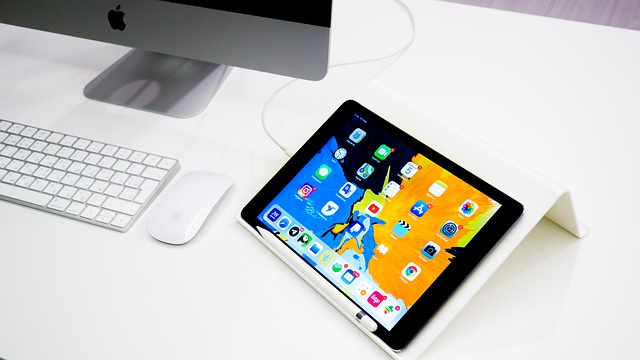Apple Focuses on Small Businesses

Earlier last week, Apple (Nasdaq: AAPL) announced its first-quarter results that surpassed market expectations. If there were any concerns about supply chain issues hurting Apple, they were soon dispelled as the company reported record-level sales across most of its segments.
Apple’s Financials
Apple’s quarterly revenues grew 11% to $123.95 billion, significantly ahead of the market’s forecast of $118.66 billion. EPS was $2.10, surpassing the Street’s forecast of $1.89.
By segment, iPhone revenues grew 9% to $71.63 billion. Mac sales grew 25% to $10.85 billion and iPad sales fell 14% to $7.25 billion. Revenues from Wearables grew 13% to $14.7 billion. The services segment revenues grew 24% to $19.52 billion.
During the December quarter, Apple set an all-time revenue record for iPhone, driven by the strong adoption of iPhone 13. It also set another all-time revenue record for Mac with customers wanting to procure the new M1-powered MacBook Air, iMac, or MacBook Pro. Similarly, it set record levels for the Wearable, Home, and Accessories segment driven by the continued adoption of Apple Watch Series 7.
App Store continued to reward the developers. Since its launch, Apple has paid developers selling digital goods and services more than $260 billion, with 2021 being a record year for their earnings.
Overall Apple’s total active device installed base grew 9% to more than 1.8 billion. The iPhone installed base grew 9% to 1.1 billion compared with the 5.4% growth reported a year ago. This acceleration in installed base growth illustrates the strength of the iPhone.
Apple did not provide any forecast for the current quarter, but they did mention that they expect the supply chain constraints to ease in the quarter. The market estimates revenues of $91.6 billion for the quarter with an EPS of $1.38 and revenues of $384.85 billion with an EPS of $5.82 for the year.
Apple’s Product Expansion
Apple recently launched the beta release of Apple Business Essentials, a service that will bring together device management, 24/7 Apple Support, and iCloud storage into a flexible subscription plan for small businesses with up to 500 employees.
The company also released a new Apple Business Essentials app that allows employees to install apps for work and request support. Within Apple Business Essentials Collections, IT personnel will be able to configure settings and apps for individual users, groups, or devices. When employees sign in to their corporate or personally owned device with their work credentials, Collections will automatically push settings such as VPN configurations and Wi-Fi passwords. In addition, Collections will also install the new Apple Business Essentials app on each employee’s home screen, to allow them to download corporate apps assigned to them. Apple is targeting the small business segment with this offering, hoping to help streamline employee device management within that market.
Recently, Apple announced its partnership with Boys & Girls Clubs of America. The partnership will bring coding to Boys & Girls Clubs in over a dozen US cities. With iPad, Apple’s Everyone Can Code curriculum, and professional support from Apple educators, kids and teens will be able to integrate coding into their programming, and get to create and collaborate on the basics of app design and development.
Apple also announced Self Service Repair, which provides access to genuine parts and tools for customers that are comfortable with completing repairs of their Apple products. It is currently available for iPhone 12 and iPhone 13 lineups but will soon be available for Mac computers that feature M1 chips. While the initial phase of the program focuses on the most commonly serviced modules, like the iPhone display, battery, and camera, additional repairs will be available later this year. Apple’s customers will join more than 5,000 Apple Authorized Service Providers (AASPs) and 2,800 Independent Repair Providers who currently are the only ones with access to parts, tools, and manuals for repair. The news was not welcomed by these vendors and repair technicians who will surely lose some of their customers.
Its stock is trading at $174.61 with a market capitalization of $2.85 trillion. It touched a 52-week high of $182.94 in December last year and a 52-week low of $116.21 in March last year. Apple is one of the very few stocks relatively unharmed by the market volatility.
Disclosure: All investors should make their own assessments based on their own research, informed interpretations, and risk appetite. This article expresses my own opinions based on my own research of product-market fit, channel execution, and other factors. My primary interest is in product strategy. While this may have bearing on stock movements, my writings tend to focus on long-term implications. The information presented is illustrative and educational, but should not be regarded as a complete analysis nor recommendation to buy or sell the securities mentioned herein. I am not a registered investment adviser and I am not receiving compensation for this article. I am an investor in this company.
Featured Videos
Can 1M/1M Help Me Raise Money?
How Does 1M/1M Democratize Entrepreneurship Education?
How Does 1M/1M Democratize Management Consulting?
When Is The Right Time To Join 1M/1M?
Can 1M/1M Help Me With Business Development?
Can 1M/1M Help Me With Market Sizing?
Can 1M/1M Help Me Validate My Product?
Will I Have Private 1-on-1 Sessions In 1M/1M?
How Does 1M/1M Help Entrepreneurs Connect With Silicon Valley?
Mentoring or Consulting?
Why Does 1M/1M Charge $1000 a Year?
Why Does 1M/1M Partner With Local Organizations?
Why Don\’t Mentoring Networks Work?
Why Is It Important To Study With 1M/1M Now?
Dan Stewart Story
Vikrant Mathur Story
